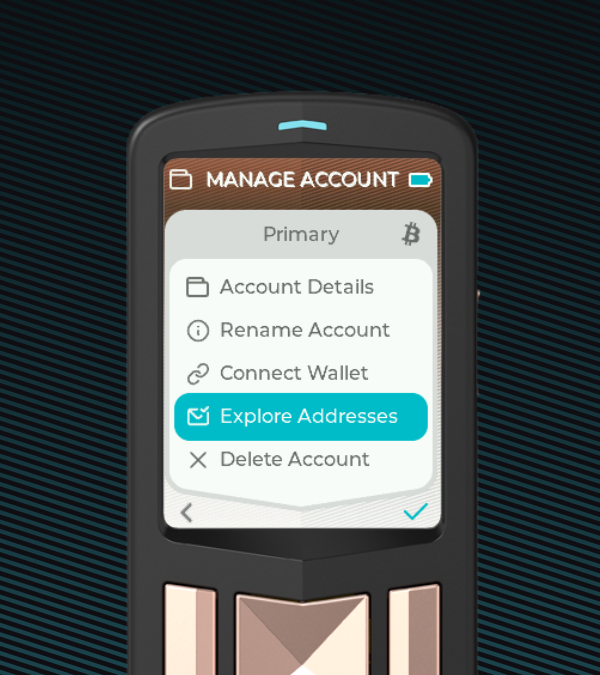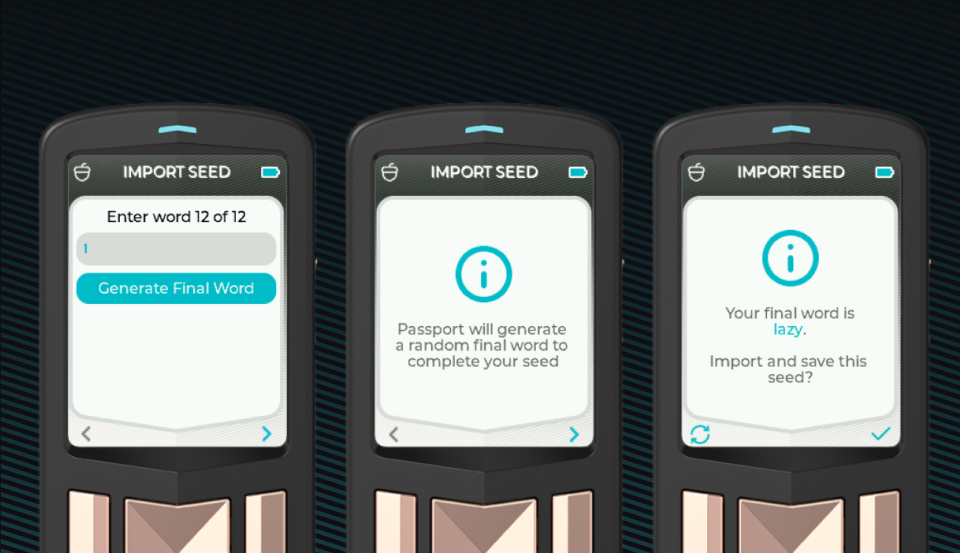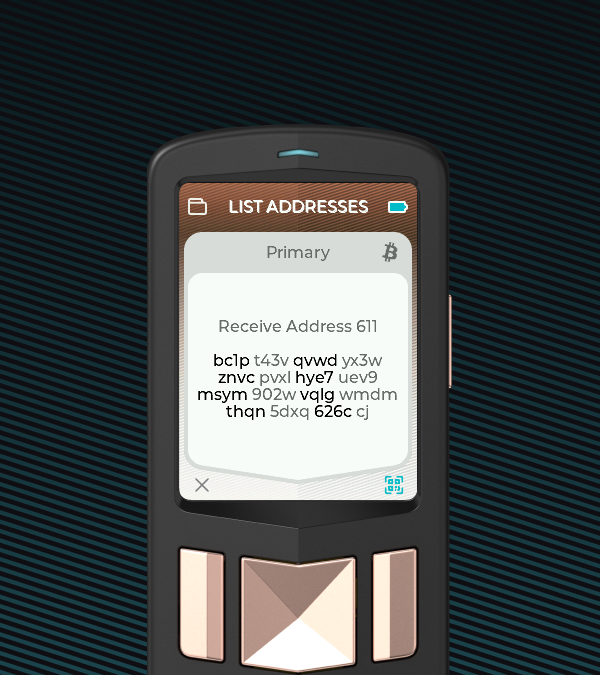
As we expand our audience to more Bitcoin beginners, we’re constantly on the lookout for ways that we can simplify and improve the user experience for those using Envoy and Passport. We’ve focused on efforts that help to abstract away the difficulties that come with the concept of seed words for new users through implementing Magic Backups in Envoy and encrypted microSD backups for Passport, but for our users to retain full sovereignty the option of using basic seed words has and always will be a core feature of our products.
One of the longest held beliefs in the Bitcoin space is that using a longer seed phrase (i.e. 24 words instead of 12) is a way to future-proof the security of your funds. Because of this belief, most hardware and software wallets default to using 24 word seeds, something that adds additional friction to users as they need to store a very large secret and verify it properly. Unfortunately, this belief is based upon a narrow view of private key security, and forces unnecessary burden on users with little to no real-world benefits.
In this blog post we’ll walk through how private key security works in Bitcoin, how seed phrases are only one piece of that security, and why we think we should make 12 word seed phrases the standard moving forward.
Don’t have time for the full post? The tl;dr is that the lowest hanging fruit for an attacker is always reverse engineering a private key from a Bitcoin address known to contain funds, even when using “only” a 12 word seed phrase. However, this is a complex and nuanced topic, so keep reading below to get a better understanding of why this is true!
What is a private key?
In Bitcoin, a private key is created through simply choosing a random number between 1 just under 2256 (that’s over 115 quattuorvigintillion for those of you keeping score). This number must be chosen in a truly random and unrepeatable way, so we rely on things called “random number generators” or “true random number generators” in computers and hardware wallets to ensure that the source of entropy (read: randomness) is good enough to produce truly random results. To get a better idea of what the chances of randomly guessing the same number as someone else are, here is a great and brief video on the topic:
The reason this number must be between 1 just under 2256 is that Bitcoin uses a 256-bit elliptic curve called secp256k1, so the most secure random number for your private key will be in that range. When you choose a number, this is translated to points on this elliptic curve (a type of graph, in essence), giving you a fully functional public key from that one number. This operation is something that is very quick to generate a private key, but practically impossible to reverse engineer a private key from a given public key (i.e. a Bitcoin address).
When you generate a private key in Bitcoin it looks something like this:
1E99423A4ED27608A15A2616A2B0E9E52CED330AC530EDCC32C8FFC6A526AEDD
Note how hard it would be to properly write down or memorize a private key in this format. Enter BIP 39, a proposal that allowed us to use a list of words to securely and deterministically (read: repeatably) generate a private key from that list of words.
Private keys made human
Seed phrases as we know and love them were introduced way back in 2013, and quickly gained adoption as they greatly simplified the process of setting up or restoring wallets in Bitcoin. As a set of words in the same order will always generate the same private keys, we can simply save these words and be sure that we can always recover funds properly. Seed words must be a minimum of 12 words in length, but can be as long as 24 words if desired.
When you generate a seed phrase, it will look something like this:
fit hen toward recycle detail raise glare gate diagram room vendor lesson
As Bitcoiners have a penchant for maxing out security and always keep a long-term view when approaching their money, most jumped directly into using the maximum length seed phrase of 24 words from the get-go, as it theoretically provided more entropy (which people viewed as more security) than smaller seed phrases. But how secure really is a seed phrase, and how does it compare to the security of a private key itself? How can an attacker actually attempt to steal funds from a given Bitcoin wallet?
Attacking your private keys
To better understand how secure private keys and seed phrases are, we first need to look at what an attacker can do to try and steal Bitcoin from your wallet through cryptography alone. There are two basic attacks that can happen against your private keys in Bitcoin:
- An attacker can attempt to guess the words and order of your seed phrase in its entirety
- An attacker can attempt to reverse engineer a private key from a given public key (Bitcoin address)
The first attack is often called a “brute-force attack,” as it involves an attacker trying over and over again to guess the correct secret – in this case a seed phrase. When using a 12 word seed phrase there are 204812 possible word combinations, of which some are able to be immediately discarded due to a failing checksum, meaning the number of valid seed phrases is actually 2128 (or 340,282,366,920,938,463,463,374,607,431,768,211,456). Yes, you read that right. In order for an attacker to correctly guess your 12 word seed phrase would require billions of years using modern supercomputers. In essence, there is no real-world possibility of an attacker correctly guessing your 12 word seed phrase.
The second attack is also known as solving the Elliptic Curve Discrete Logarithm Problem (ECDLP). While it is trivial to generate a private key and derive public keys from it, there is no efficient way to recover a private key from a given public key. The asymmetry of this aspect of elliptic curve cryptography is at the core of securing Bitcoin (along with many other tools for freedom, including HTTPS security for websites, the Tor network, Signal messenger, and more). As Bitcoin reveals all public keys and amounts publicly, an attacker could choose a given public key with a large amount of Bitcoin (i.e. Satoshi’s known addresses) and attempt to solve the ECDLP for that public key.
Bitcoin uses the secp256k1 elliptic curve, a 256-bit curve that is well understood and vetted in the cryptography space. An attacker would need to leverage the best known attack, Pollard’s rho algorithm, which takes a number of operations equal to about half the curve size. This means that an attacker attempting to solve the ECDLP for a given Bitcoin address would need to perform 2128 operations (or 340,282,366,920,938,463,463,374,607,431,768,211,456) in order to guess the private key correctly. Performing that many operations on modern computers would take in the billions of years. In essence, there is no real-world possibility of an attacker solving the ECDLP for a given public key.
To put those numbers in perspective, solving the ECDLP for your public key or guessing your seed phrase randomly is less likely than picking the same atom out of the universe. The security provided by the unimaginably large numbers we’re discussing here securing your Bitcoin keys is hard to fathom, but comparing it to more tangible numbers like these can help. This security means that attacking a 12 word Bitcoin seed or solving the ECDLP for a given Bitcoin address are both considered infeasible with modern computers.
12 words is the sweet spot
So how does this all add up to a 12 word seed phrase being the ideal length? A 12 word seed phrase contains 128 bits of entropy, allowing it to be used to generate private keys with the full 128 bits of security provided by secp256k1. We broke down the rough estimates for solving the ECDLP or guessing a given 12 word seed phrase previously, but this means that a 12 word seed phrase is the minimum length to not hamper the security of the underlying private keys. If we shortened the seed to, say, 10 words, we would be reducing the security of the private keys and making both the underlying private keys more insecure and providing an easier brute-force attack against the seed words.
If you were to use a 24 word seed phrase, even though it would provide additional entropy when generating private keys, the underlying private key would still be broken in 2^128 operations — exactly the same as a 12 word seed. This means that longer seed phrases will not add additional security to the underlying private keys themselves, and only increase the difficulty of brute-forcing a given seed phrase (something that is already statistically impossible for a 12 word seed phrase).
12 words is enough.
— Adam Back (@adam3us) March 13, 2023
While we can increase the protection against brute-force attacks of a seed phrase by increasing the number of words, the core security of your funds in Bitcoin remain the security of the underlying private key itself — even when using a longer seed phrase. The lowest hanging fruit for an attacker is always to attack the cryptographic security of a Bitcoin address they know contains Bitcoin, rather than attempt to guess a seed phrase with funds.
Bringing things back to reality
In summary, the security of a 12 word seed phrase is roughly equivalent to that of the underlying security of a private key in Bitcoin, and any additional theoretical security gained through using a larger seed phrase has no impact on real-world attacks. 12 words provide the required amount of entropy to generate a secure private key and more than enough security against a brute-force attack at the same time.
It’s important to note that far and away the largest cause of lost Bitcoin is not theft, but rather a user failing to properly secure their seed phrase. Any reduction in the barrier of entry to proper backup, storage, and recovery of a seed phrase will lead to a real reduction in the amount of Bitcoin lost forever. In addition, the other major ways to lose funds are to have them stolen by an attacker finding a seed phrase or socially engineering a user into giving up their seed phrase. Both of these attacks do not gain any protection or resilience through using a longer seed phrase.
If no additional security is gained in the real world by doubling the length of the secret we need people to store from 12 words to 24, doubling the amount of words to enter when restoring, and doubling the amount of words to verify on initial setup, we can further lower the barrier of entry to Bitcoin by leveraging the immense security provided by “only” a 12 word seed phrase for all new users.
We do still think it’s important to abstract away the foreign concept of seed words whenever possible, but we will always want our users to be able to easily move to other wallets, be protected if we disappear one day, and have full sovereignty when it comes to their private keys. As a result we will always build in strong and seamless support for seed words in our products, and starting soon we will default to 12 words when creating a new wallet in Passport.
Let’s make 12 words the standard.
Dive deeper
If this intro to private key security piqued your interest, we’ve collected our favorite resources on the topic below for you to learn more about how the cryptography and security behind Bitcoin’s immensely powerful design:
- Adam Back on seed phrase length
- Andreas Antonopoulos on seed phrase length
- Bitcoin Book – From mnemonic to Seed
- Elliptic Curve Cryptography – Key Strength
- Time to brute force a seed phrase compared to the age of the universe
- The ECDLP and Bitcoin
- SafeCurve
A special thank you to Luke Parker, a brilliant developer and cryptographer in the space who helped to review and give detailed feedback in the process of writing this post.

























































































































































































































